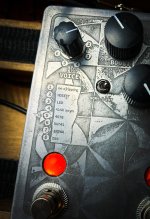jhaneyzz
Well-known member
OK... stop me if you've heard this one...
I've been building a lot of pedals lately that use germanium diodes.
I've got some of the rarest germanium diodes I've ever seen and they are cool as F@#$. Thanks Nathan...
I've built a Stockade with 8 different diode clipping options...
I've watched every YouTube diode comparison ever recorded.
Except for the volume difference brought on by the change in forward voltage... I can't tell a lick of difference.
I can definitely hear the difference in hard clipping, and I can convince myself that there's a difference in symmetrical and asymmetrical clipping (just barely) but not a difference in the "character" of the one (aside from the volume change)
Please... if I'm wrong, set me straight. but WTF?
I've been building a lot of pedals lately that use germanium diodes.
I've got some of the rarest germanium diodes I've ever seen and they are cool as F@#$. Thanks Nathan...
I've built a Stockade with 8 different diode clipping options...
I've watched every YouTube diode comparison ever recorded.
Except for the volume difference brought on by the change in forward voltage... I can't tell a lick of difference.
I can definitely hear the difference in hard clipping, and I can convince myself that there's a difference in symmetrical and asymmetrical clipping (just barely) but not a difference in the "character" of the one (aside from the volume change)
Please... if I'm wrong, set me straight. but WTF?


